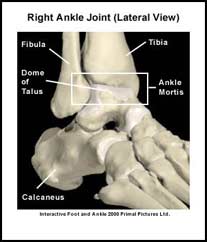In order to understand this condition, it is important to understand the anatomy and function of the foot. Please read Foot Pain Info’s section on basic foot anatomy. For additional background information on the biomechanics of the foot please read Foot Pain Info’s section on basic foot and ankle biomechanics.

What is an osteochondral fracture of the talar dome?
The talus is the tallest bone in the foot. It is also one of the bones that makes up the ankle joint. The upper part of the talus is called the talar dome. The dome is made up of bone (osteo) that is covered by a layer of articular cartilage (-chondral). Articular cartilage is a smooth shiny material that allows the ankle bones to slide easily over each other as the ankle moves. When a part of the dome cracks or breaks off, it is referred to as an osteochondral fracture of the talar dome. These fractures usually occur as a result of an ankle injury or an ankle sprain.
What does an osteochondral fracture of the talar dome feel like?
These fractures are a frequently overlooked complication of an ankle sprain. After an ankle sprain, initial improvements in pain may occur as the injured ligaments of the ankle heal. However, when a osteochondral fracture of the talar dome is also present, there may be persistent pain deep in the ankle. Pain and swelling may occur after return to activity. A catching or locking sensation may also be noticed. An examination of the affected ankle may reveal tenderness or swelling.
How are osteochondral fractures of the talar dome detected?
Osteochondral fractures of the talar dome can be seen on regular x-rays. If initial ankle x-rays are normal, follow-up x-rays or a bone scan may be required. In some cases other diagnostic tests, such as CT scans or MRI’s, may be necessary to evaluate the extent of the injury.
How are osteochondral fractures of the talar dome treated?
The treatment of osteochondral fractures of the talar dome should be individualized. Treatment options may include relative rest, the use of crutches, non-weight bearing, or immobilization in a cast. The length of time in a cast varies depending on the severity of the fracture. More severe fractures may also require surgery. Once the osteochondral fracture of the talar dome has healed, a rehabilitation program is important to regain range of motion of the ankle, increase strength and flexibility of the lower leg, and improve balance.
What other information is available on osteochondral fractures?
Foot Pain Info’s links section has additional information on this topic. Links have been provided to other websites as well as online medical journals. Visit Joint Pain Info for information on other joint injuries and problems.
